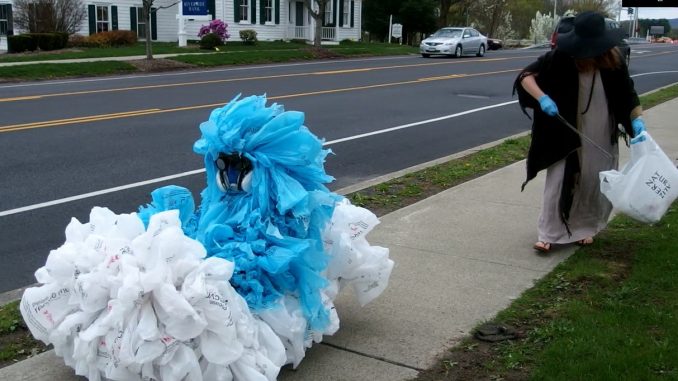
How did you celebrate this year’s Earth Day on April 22? Maybe you posted a photo of the divine Catskill mountains with a caption articulating your appreciation for the Earth’s beauty. Or perhaps you merely made a conscious effort to toss your plastic coffee cup lids into the recycling bin.
But two SUNY New Paltz sculpture students, Maxine Leu (MFA) and Sanford Fels (BFA), took environmental awareness to a whole other level through a unique performance art involving a Plady—a name shortened from plastic lady—and “Toxicar.”
Created by Leu, a Taiwanese self-proclaimed environmental artist, Plady came to be through the weaving and tying of 500 reused plastic bags from a New Paltz supermarket. These 500 plastic bags represent the number of plastic bags that an average American uses and discards every year.
“I focus on garbage problems, global warming and human selfishness of resource waste,” Leu said. “So instead of just using recycling material to make a beautiful piece of art, I utilize perspectives of mixed culture, comparative observation, universal symbols, contrasting elements, dark playfulness and personification and metaphors of insulting humor to make the topic educational.”
This is not the first time Plady has made an appearance in New Paltz. On Dec. 10, 2017, Plady made its opening debut with a video entitled “The Bags,” a humorous visual narrative of Plady browsing the aisles of Tops and proceeding to self-checkout with the ruffling of plastic bags with every step.
The video ends with the text “My name is Plady. I was created by you. The next generation is becoming like me, living in a plastic world.”
This year, Fels was the person behind the bags. To make their own personal touch on Plady, Fels concealed their face with a gas mask and goggles.
Leu’s and Fels’ plan was to start at Tops and make their way down Main Street to campus, picking up any trash they saw as they walked and rode in the Toxicar. By the time they reached the New Paltz Animal Hospital, all of their bags were already full.
“People who walked by us did most things you’d imagine,” Fels said. “I was told that the costume was pretty unsettling the closer you got to it, so I think people avoided getting too close. This woman and her caretaker from a disability service place came up to us and asked us a whole bunch of questions…that was really sweet actually.”
Plady was born in 2015 when Leu went shopping for the first time in an American supermarket. It was here where Leu observed the stark differences between how Americans and Taiwanese treat plastic bags.
In Taiwan supermarkets, they do not provide free plastic bags to customers and haven’t done so in more than 10 years. Taiwan also strictly regulates recycling. To dispose of recyclables and garbage, citizens buy special bags from their government which they use to divide waste into stringent categories.
“The person who takes your recycling will inspect your bags to
In most Taiwan restaurants, patrons are expected to bring their own glass container for leftovers. Every teacher, in all grades, are required to take government-sponsored environmental workshops and then share that information in their classrooms. According to Leu, the mass media’s message that plastics are unhealthy and can kill you is pervasive in Taiwan.
“It’s tough to talk about this topic to people who have never had the same experience. Therefore, I wanted to use my art as a platform for cross-cultural communication to speak to this situation,” Leu said. “I always think that art should not only exist in galleries or museums for people who came to the show, it should be a part of our everyday lives.”
In a past sculpture installation entitled “Blue Ocean,” Leu explored the relationship between money and environmental protection by fashioning a tunnel out of 300 Tops plastic bags.
“The connection made between these two elements are that people prefer to spend money on ‘buying pollution’ merely for the sake of convenience, but the action has no thought of the needed production and usage of plastic bags,” Leu said.
After the show, Leu took down the installation and reused the material to create Plady. Through this performance art, Leu hopes to raise awareness, in a humorous way, about the excessive and frivolous use of plastic bags.
“Like mud can become clay, and then ceramics, I feel that as an environmental artist, I can use trash to produce treasure,” Leu said. “My parents gave me the best gift by modeling the behavior of treasuring everything we had. We didn’t throw things out easily and we fixed old things and continued using them.”

